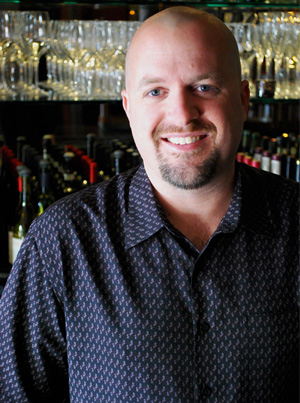Jeff Berlin was the opening wine director at Oakland’s A Côté. Over the past 13 years, he’s increasingly turned to Europe’s lesser-know yet historic wines and terroirs, especially the wines of Eastern Europe, to match chef Matthew Colgan’s hearty small plates.


Eastern European wines have been a major force for you again this year, with wines from both Hungary and Croatia selling well. Tell me about your top-selling wine, the Eszterbauer Szekszárdi Kadarka 2011.
I have a personal attachment to it because it was something Frank Dietrich [of Blue Danube Wine Company] and I found when we were in a wine bar in Budapest. He went on to strike up a relationship with them, and they’ve become very successful. It’s from an area that makes that Bull’s Blood style of wine, big dense blends of local grapes, but this kadarka is more pinot-like, light and peppery and complex. When that’s on the list we sell more of it than anything else. It’s been our most successful for the last two years.
Any particularly exciting new discoveries this year from that region, either producers or new growing areas or historical elements?
Bibich Ambra; it’s a late harvest sort of passito-style wine. Straw mats, then several years in barrel, made of the debit grape. It blows people away because of its really expressive, subtle rancio aromatics—burnt toffee, tobacco, straw—but still has really bright, lively acidity, and doesn’t finish too viscous by any means.
Or Samuel Tinon—a French guy whose spent 15 years in Hungary—makes this crazy wine called Szamorodni. It’s a sweet wine normally, but he makes a dry version. It’s like a botrytised Vin Jaune from Hungary! It’s nice and dry, beautifully aromatic.
These are two wines that are super-earthy with all sorts of tertiary aromatics that blow people away. We recommend them with cheese plates, terrines…they’re just such versatile wines with our food and they also challenge peoples’ perceptions about wine pairings.
People are constantly taking pictures of the bottles with their cell phones.
Your wine program is focused on wines that a lot of people would consider obscure, in terms of either variety or region of origin. How are you able to make guests comfortable with wines they might not recognize or be able to fit into their frame of reference?
People show up ready to party! There’s something about, I guess, the reputation of coming here that leads people to want to have a culinary adventure and wine adventure. We just ride with it, and try not to let them down—showing them things that are new and exciting, and really old and traditional. At this point it’s easy.
Any wines you’ve struggled to sell, despite your clientele being pretty open-minded?
We get people to drink all sorts of crazy things here, and yet we always struggle with riesling. People do actually consume massive amounts of sugar in their food and drink, but if you ask them, they say they don’t want anything sweet. But the past couple of years, and even with our riesling selections, we’ve started to get people turned around a bit. I’ve been doing more with older vintages, Spätlesen and Auslesen from the late ’80s and early ’90s that have been blowing people away. People seem to be a bit more open to sweetness in their wine, and to redefine what they perceive as sweet and what riesling can be. Right now we’re doing a flight of wines from Schloss Schönborn, ’94 Spatlesen and ’89 Auslesen from a couple of different vineyards. We’re having a hard time keeping them in stock! They’re a little bit pricier, but people are going for it.
While people may pony up for a nice bottle of riesling now and then, your top-selling wines seem to fall within the narrow $40-60 range. Why is that?
Over the years it’s evolved to reflect what people are looking to spend in our neighborhood. We do have a few older bottles for special occasions, but for the most part people who come here are looking to taste multiple glasses or multiple bottles of wine. It’s also a sweet spot in terms of quality—wines that would challenge what people would spend $100 on from a place like Napa, or a better-known place in Europe like Burgundy and Bordeaux. You can get solid, really outstanding, memorable glasses of wine for $10-14 bucks on our list. And bottles in the $50-60 range—some of the most spectacular wines I drink all year long are in that price range. But it wasn’t always that way—it’s an evolution of the economy, the neighborhood, our style of wine.
You list the 2011 Reale Tramonti Campania Per’ e Palummo Rosato is your new biggest success—has it taken a lot of pushing to get tables to order a bottle of Italian rosé, or not really?
Rosé is never a problem here—we have a huge pink wine audience. We’ve got maybe six to eight rosés in the house in the middle of winter. It’s always been that way here. We try to have the light, clean, minerally version all the way to the borderline-red version, that feels almost like a tannic red wine at room temp. The rosé from Reale is one of the more pronounced and robust rosés we carry and yet it’s perfectly balanced, a magical wine where everything is perfect and harmonious in the glass—it sparkles.
If you were eating dinner at A Côté tonight, what would you absolutely have to order, and what would you drink with it?
That’s always a struggle every night when it’s time…. We’re doing a pork tenderloin Milanese, kinda like schnitzel, with cabbage and bacon and potatoes fried with duck fat. I’ve been loving that ’89 Auslese from Schloss Schönborn. I can’t get enough of it, really.
It seems like there have been a lot of new openings in Oakland recently. What have you noticed about the Oakland dining scene since you helped open A Côté 13 ago?
It’s had a couple of attempted renaissances with restaurants. We were a part of the initial one—a handful of new restaurants opening within a year or so in Oakland and Berkeley. Then that subsided, some closed. That’s maybe happened a few tines since we’ve been here, but the explosion in the last year or year-and-a-half has been spectacular. People understand the potential in different parts of Oakland, people from San Francisco are getting on board, it’s great for business all around. We’re super excited to have more restaurants open right here on College Avenue—four or five in the last year. I’ve always felt it brings more people to the area. All the restaurants are full at least for the main dinner hour. And it keeps us honest—if people have a lot of options, we’ve got to be doing things right.
Longtime senior editor at Wine & Spirits magazine, Luke now works for the Stanford Technology Ventures Program.
















